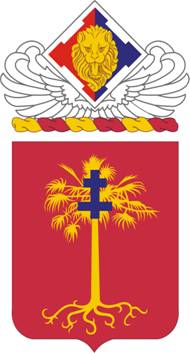
The 101st Airborne Division (Air Assault) ("Screaming Eagles") is a light infantry division of the United States Army that specializes in air assault operations. It can plan, coordinate, and execute multiple battalion-size air assault operations to seize terrain. These operations can be conducted by mobile teams covering large distances, fighting behind enemy lines, and working in austere environments with limited or degraded infrastructure. Its unique battlefield mobility and high level of training have kept it in the vanguard of U.S. land combat forces in recent conflicts: for example, foreign internal defense and counterterrorism operations in Iraq, in Afghanistan in 2015–2016, and in Syria, as part of Operation Inherent Resolve in 2018–2021.
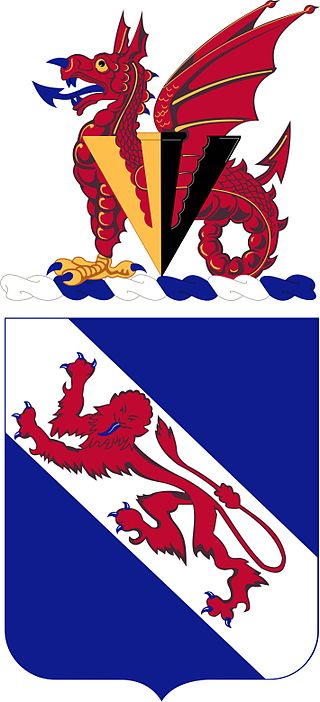
The 508th Infantry Regiment is an airborne infantry regiment of the United States Army, first formed in October 1942 during World War II. The 508th is a parent regiment under the U.S. Army Regimental System, and two battalions from the regiment are currently active: the 1st Battalion, 508th Parachute Infantry Regiment is assigned to the 3rd Brigade Combat Team, 82nd Airborne Division, and the 2nd Battalion, 508th Parachute Infantry Regiment is assigned to the 2nd Brigade Combat Team, 82nd Airborne Division. The regiment served in combat during World War II, and regimental elements have served in combat in the Dominican Republic, Vietnam, Grenada, Panama, Iraq and Afghanistan.
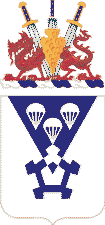
The 503rd Infantry Regiment, formerly the 503rd Parachute Infantry Regiment and the 503rd Airborne Infantry Regiment, is an airborne infantry regiment of the United States Army. The regiment served as an independent regiment in the Pacific War during World War II; at Fort Campbell, Kentucky; in Okinawa, Japan; and in Germany. Regimental elements have been assigned to the 2nd Infantry Division, the 11th Airborne Division, the 24th Infantry Division, 25th Infantry Division, the 82nd Airborne Division, 101st Airborne Division, and the 173rd Airborne Brigade Combat Team. Regimental elements have participated in campaigns in the Vietnam War, Operation Enduring Freedom–Afghanistan, and Operation Iraqi Freedom. The regiment claims 15 Medal of Honor recipients: two from World War II, ten from Vietnam, and three from Afghanistan. A parent regiment under the U.S. Army Regimental System. The regiment's 1st and 2nd Battalions are active, assigned to the 173rd Airborne Brigade, based at Caserma Ederle, Vicenza, Italy. The 3rd and 4th Battalions as well as Companies E, F, G, H, and I have been inactived.
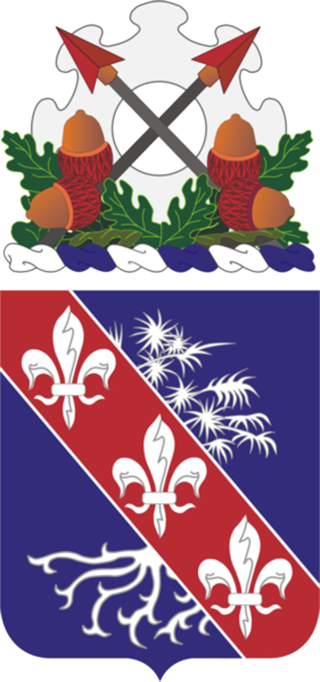
The 327th Infantry Regiment is an infantry regiment of the 101st Airborne Division of the United States Army. During World War II, the 327th was a glider-borne regiment of the 101st Airborne Division. It fought during World War I as part of the 82nd Division. It has also been deployed in the Vietnam War, Gulf War, and most recently to Iraq and Afghanistan. The song "Glider Rider" describes (humorously) some of the slights that glider-borne troops felt they received from the Army during World War II; though the regiment's public fame rose with the 1949 movie Battleground about the Siege of Bastogne in late 1944.

The 1st Battalion, 320th Field Artillery Regiment is the field artillery battalion assigned to the 2nd Brigade Combat Team, 101st Airborne Division. The battalion has been assigned to the 82nd Airborne Division, 11th Airborne Division and 101st Airborne Division. The battalion has participated in World War I, World War II, Operation Power Pack, Operation Urgent Fury, Operation Desert Storm, Operation Iraqi Freedom, Operation Enduring Freedom, and Operation Inherent Resolve.
The United States Army Regimental System (USARS) is an organizational and classification system used by the United States Army. It was established in 1981 to replace the Combat Arms Regimental System (CARS) to provide each soldier with continuous identification with a single regiment, and to increase a soldier's probability of serving recurring assignments with his or her regiment. The USARS was intended to enhance combat effectiveness by providing the opportunity for a regimental affiliation, thus obtaining some of the benefits of the traditional regimental system.
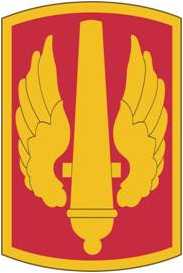
The 18th Field Artillery Brigade is the XVIII Airborne Corps field artillery brigade, based at Fort Bragg, North Carolina.

The 4th Battalion, 319th Field Artillery Regiment is the field artillery battalion assigned to the 173rd Airborne Brigade. Nicknamed "The King of the Herd", 4–319th AFAR has participated in battles from World War I to current operations around the globe. The battalion's mission is to provide direct supporting fires to the brigade. The unit is skilled in both the art of integrating and synchronizing all available fire support assets and in the science of delivering accurate and timely lethal and non-lethal fires. "King of the Herd" Paratroopers in the 173rd Infantry Brigade Combat Team (Airborne) are able to accomplish both of these tasks and other assigned missions after rapidly deploying via parachute assault.

The 3rd Battalion, 319th Field Artillery Regiment is the field artillery battalion that directly supports the 1st Brigade Combat Team, 82nd Airborne Division. Known as the "Gun Devils", 3–319th AFAR has participated in battles from World War I to the current day, and is one of the most highly decorated field artillery units in the United States Army. The battalion's mission is "3-319th AFAR stands ready to deploy worldwide within 18 hours of notification, execute a parachute assault and conduct full-spectrum operations. Specifically, the battalion will provide responsive lethal and nonlethal fires in support of forcible entry and airfield seizure, and integrate and synchronize the effects of fires to achieve the 1BCT commander's intent."

The 319th Field Artillery Regiment, more commonly referred to as the 319th Airborne Field Artillery Regiment, is a parent regiment in the U.S. Army Regimental System. Four battalions of the regiment are currently active. The first three battalions 1st Battalion, 319th Field Artillery Regiment, 2nd Battalion, 319th Field Artillery Regiment, 3rd Battalion, 319th Field Artillery Regiment are in the 82nd Airborne Division and the 4th Battalion, 319th Field Artillery Regiment is in the 173rd Airborne Brigade.

The 321st Field Artillery Regiment is a field artillery regiment of the United States Army. A parent regiment under the U.S. Army Regimental System, the 321st FAR currently has one active battalion, the 3rd Battalion, 321st FAR, assigned to the 18th Field Artillery Brigade at Fort Bragg, NC. The battalion is equipped with M142 HIMARS.
The regiment served with the 82nd Division during World War I and with the 101st Airborne Division during World War II. Elements of the regiment have served with the 82nd and 101st Airborne Divisions in Vietnam, and with the 82nd Airborne Division and 18th Field Artillery Brigade during the Global War on Terrorism.
The 377th Field Artillery Regiment is a field artillery regiment of the United States Army. A parent regiment under the U.S. Army Regimental System, the regiment's 2nd Battalion, 377th Field Artillery Regiment is assigned to the 2nd Infantry Brigade Combat Team (Airborne), 11th Airborne Division. Elements of the regiment have also served with the 101st Airborne Division and 82nd Airborne Division, and have seen service in World War II, Vietnam, and in both Iraq and Afghanistan during the Global War on Terror. The 1st and 3rd Battalions as well as Batteries D and E are Inactive.
The 2nd Battalion, 319th Field Artillery Regiment is the field artillery battalion that is assigned to the 2nd Brigade Combat Team, 82nd Airborne Division. Nicknamed "Black Falcons", 2–319 AFAR has participated in battles from World War I to the current day.
The 82nd Airborne Division Artillery (DIVARTY) is the divisional artillery command for the 82nd Airborne Division of the United States Army, stationed at Fort Bragg, North Carolina. It was organized in 1917, during World War I, was inactivated in 2006 as part of the transformation to modular brigade combat teams, and was reactivated in 2014.

The 1st Battalion, 321st Field Artillery Regiment is an inactive field artillery battalion of the United States Army. The battalion served in World War I, World War II, Vietnam and the Global War on Terror with the 82nd Airborne and 101st Airborne Divisions, and with the 18th Field Artillery Brigade. The battalion was officially inactivated in March 2014, and its firing batteries were distributed throughout the 82nd Airborne Division.
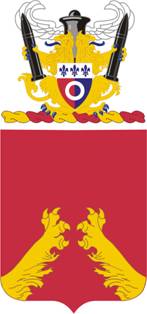
The 2nd Battalion, 321st Field Artillery Regiment is an inactive field artillery battalion of the United States Army. The battalion served in World War I, World War II, Vietnam and the Global War on Terrorism with the 82nd Airborne and 101st Airborne Divisions. The battalion was inactivated in 2014 as part of force reductions.

The 101st Airborne Division Artillery (DIVARTY) is the force fires headquarters for the 101st Airborne Division at Fort Campbell, Kentucky. The DIVARTY has served with the division in World War II, Vietnam, Operations Desert Shield and Storm, Operation Iraqi Freedom, and in peacetime at Camp Breckinridge and Fort Campbell, Kentucky, and Fort Jackson, South Carolina. The DIVARTY was inactivated in 2005 as part of transformation to modular brigade combat teams, but was reactivated on 16 October 2014 to provide fire support coordination and mission command for the training and readiness of field artillery units across the division.

The 2nd Battalion, 320th Field Artillery Regiment is an inactive field artillery battalion of the United States Army. The battalion has been assigned to the 82nd Airborne Division, 11th Airborne Division and 101st Airborne Division. The battalion has participated in World War I, World War II, Vietnam, Operation Desert Storm, Operation Iraqi Freedom, and Operation Enduring Freedom. The battalion deactivated in July 2015 as part of ongoing force reductions, and its personnel and equipment were reflagged as the 2nd Battalion, 32nd Field Artillery Regiment.

The 3rd Battalion, 320th Field Artillery Regiment is a Field Artillery Branch battalion assigned to the 3rd Brigade Combat Team, 101st Airborne Division. The battalion has been assigned to the 82nd Airborne Division, 11th Airborne Division and 101st Airborne Division. The battalion has participated in World War I, World War II, Operation Desert Storm, Operation Enduring Freedom, and Operation Iraqi Freedom.

The 4th Battalion, 320th Field Artillery Regiment is an inactive field artillery battalion of the United States Army. The battalion has been assigned to the 82nd Airborne Division, 11th Airborne Division and 101st Airborne Division. The battalion has participated in World War I, World War II, Operation Just Cause, Operation Iraqi Freedom, and Operation Enduring Freedom. The battalion inactivated in 2014 as part of ongoing force reductions
